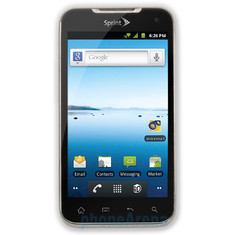LG Viper 4G LTE - specs from phoneArena.com
Pros
- Fast mobile data support (4G)
Cons
- Low pixel density screen (233 ppi)
- Too little RAM memory (1024 MB RAM)
- Low resolution display (480 x 800 pixels)
- Low-resolution camera (5 megapixels)
Description
Design
- Device type:
- Smart phone
- OS:
- Android (4.0.4)
- Dimensions:
- 4.59 x 2.44 x 0.46 inches
(117 x 62 x 12 mm)
- 4.59 x 2.44 x 0.46 inches
- Weight:
- 5.00 oz (142 g)
the average is 5.3 oz (152 g)
- 5.00 oz (142 g)
Display
- Physical size:
- 4.0 inches
- Resolution:
- 480 x 800 pixels
- Pixel density:
Pixel density - The pixel density of a display represents the number of pixels over an area of one inch. It’s measured in “pixels per inch”, or ppi. The higher the number, the more detailed and good-looking the display is.
- 233 ppi
- Technology:
Technology - There are two main screen technologies currently used in phones and tablets: LCD and AMOLED. The former usually features a light source and liquid crystals, while the latter is based on organic light-emitting diodes. Newer LCD variations like IPS-LCD and Super-LCD allow for very accurate color reproduction and very wide viewing angles, where no significant image quality loss is observed. Current AMOLED screens differ in such a way that they can exhibit much more saturated colors (sometimes too much) and incredibly high contrast levels, which is due to black color being completely black in AMOLED displays.
- TFT
- Screen-to-body ratio:
- 63.03 %
- Features:
- Light sensor, Proximity sensor, Scratch-resistant glass
Camera
- Camera:
- 5 megapixels
- Flash:
- LED
- Features:
- Autofocus, Geo tagging
- Camcorder:
- Yes
- Features:
- Video calling
- Front-facing camera:
- 0.3 megapixels VGA
Hardware
- Processor:
Processor - The processor is the main computing component of a phone and is a major factor when it comes to the overall speed of the device. Some more powerful smartphones use dual-core and quad-core processors designed to deliver greater performance.
- Dual-core, 1200 MHz
- Graphics processor:
- Yes
- System memory:
System memory - System memory, or RAM memory is the type of memory that the device uses to temporarily store data from the OS or currently-running apps. The more RAM available to the device, the better the performance will be when multiple or heavier programs are running.
- 1024 MB RAM
- Built-in storage:
- 2 GB
- Storage expansion:
- microSD, microSDHC up to 32 GB
Battery
- Talk time:
- 7.00 hours
the average is 14 h (857 min)
- 7.00 hours
- Capacity:
- 1700 mAh
Multimedia
- Music player:
- Filter by:
- Album, Artist, Playlists
- Features:
- Album art cover, Background playback
- Filter by:
- Speakers:
- Earpiece, Loudspeaker
Technology
- CDMA:
CDMA - Code Division Multiple Access. A technique of multiplexing, also called spread spectrum, in which analog signals are converted into digital form for transmission. For each communication channel, the signals are encoded in a sequence known to the transmitter and the receiver for that channel. The foremost application is digital cellular phone technology from QUALCOMM that operates in the 800MHz band and 1.9GHz PCS band. CDMA phones are noted for their excellent call quality and long battery life.
- 800, 1900 MHz
- FDD LTE:
- 1900 (band 2) MHz
- Data:
- LTE
- Positioning:
Positioning - This field shows the positioning systems supported by the device. There are three main types: GPS, A-GPS and GLONASS. GPS - This is one of the most widespread global positioning technologies, developed and maintained by the U.S. government. It uses satellites in order to detect your location. Works best in clear weather. A-GPS - A-GPS stands for Assisted GPS and is the industry standard for positioning and navigation. “Assisted” means that it can use local wireless networks, in addition to satellites, for quicker and more precise localization. GLONASS - GLONASS is a global positioning system, developed by the Russian Federation. It’s very similar to GPS, but isn’t so popular in cell phones.
- A-GPS
- Navigation:
- Yes
Connectivity
- Bluetooth:
- 3.0
- Wi-Fi:
- 802.11 b, g, n
- Mobile hotspot:
- Yes
- USB:
- USB 2.0
- Connector:
- microUSB
- Features:
- Mass storage device, USB charging
- Other:
- NFC, Computer sync, OTA sync
Other features
- Notifications:
- Music ringtones (MP3), Polyphonic ringtones, Vibration, Flight mode, Silent mode, Speakerphone
- Sensors:
- Accelerometer
- Hearing aid compatibility:
- M4, T4
- Voice dialing, Voice commands, Voice recording
To see the full specifications with in-depth details click here.
This device is also known as LG Viper, LG LS840
